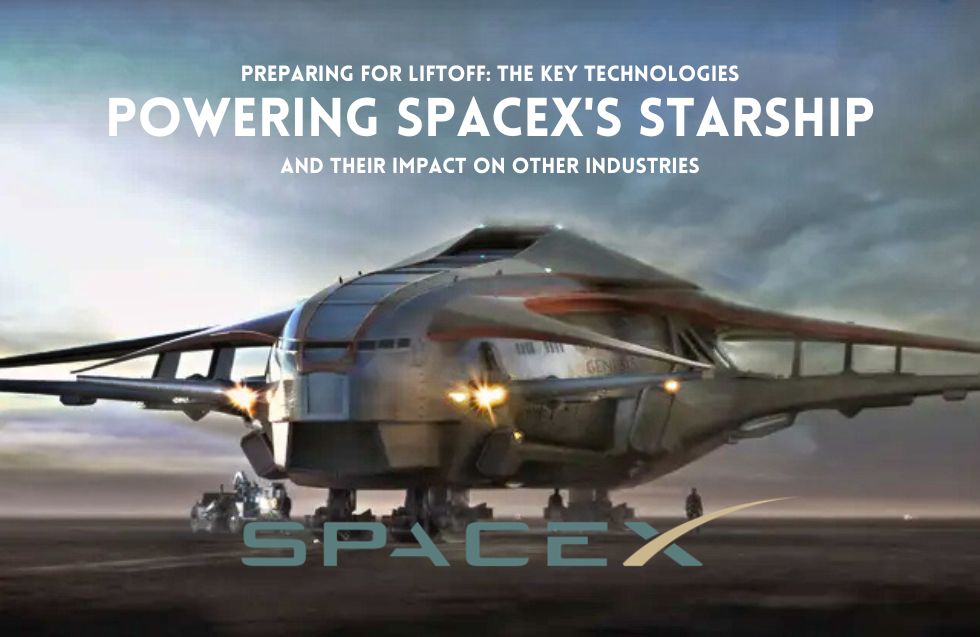SpaceX’s Starship is set to be one of the most ambitious spacecraft ever built, pushing the boundaries of technology and engineering to achieve interplanetary travel. However, beyond the obvious goal of reaching Mars, Starship’s groundbreaking technologies are also creating waves in industries far beyond aerospace. In this blog, we’ll take a closer look at some of the key technologies driving SpaceX’s Starship and explore how they’re influencing other sectors, from transportation to materials science.
1. Reusable Rocket Technology
Starship’s Goal: One of Starship’s most revolutionary aspects is its full reusability. While traditional rockets are single-use, SpaceX aims to have both the Starship vehicle and its booster (the Super Heavy) land back on Earth for reuse. This reduces the cost of each flight by millions of dollars, making space travel more accessible.
Impact on Other Industries:
- Aviation: Reusability in rockets is pushing the aviation industry to consider new ways of minimizing the cost of flights through sustainable materials and design. The concept of reusable rocket boosters inspires the creation of reusable components in aviation engines, which could make commercial air travel more affordable and eco-friendly. Additionally, the idea of suborbital flights for high-speed passenger transport—reaching any part of the world in under two hours—is being explored as a future alternative for long-haul flights.
- Logistics and Freight: The innovations in reusable rocket technology could revolutionize high-speed cargo transportation. Companies are investigating the possibility of launching goods via rockets, dramatically reducing global shipping times. For critical and high-value cargo like medical supplies, this technology could ensure rapid, secure delivery, giving the logistics industry new solutions for timely supply chain management.
- Sustainable Infrastructure: The concept of reusability is influencing infrastructure for building and waste reduction. Industries are beginning to adopt modular, reusable designs for industrial structures, mimicking SpaceX’s Starship “build, use, and repeat” model to reduce costs and waste.
2. Methane-Powered Raptor Engines
Starship’s Goal: Unlike most rockets that rely on traditional rocket fuels, SpaceX’s Starship Raptor engines use liquid methane and liquid oxygen. Methane can be sourced on Mars, making it ideal for future interplanetary missions, as it enables a refueling strategy that leverages resources from other planets.
Impact on Other Industries:
- Energy Sector: Methane-based propulsion research is helping the energy sector develop cleaner, more efficient methods for using natural gas, which emits less CO₂ than other fossil fuels. Innovations in methane handling and storage are enabling better power plant efficiency and more sustainable fuel generation. Companies are also investigating methane extraction from renewable sources, like organic waste, to generate biofuel that reduces overall greenhouse gas emissions.
- Automotive Industry: Methane combustion technologies are influencing heavy-duty vehicles, especially in sectors that rely on powerful engines, such as trucking and shipping. Engineers are looking to replicate the efficiency of methane-powered rockets to develop greener engine systems in large vehicles, which could contribute to the global shift toward lower-emission transportation.
- Agricultural Waste Management: Methane propulsion technology has spurred interest in capturing methane from animal farms and converting it into biofuel. Agriculture and waste management industries are exploring methane as a renewable energy source, aligning with sustainability initiatives while reducing harmful emissions.
3. Carbon Fiber and Advanced Alloys
Starship’s Goal: To handle the extreme temperatures and stresses of space travel, SpaceX’s Starship is pioneering the use of advanced stainless steel alloys and carbon-fiber materials in Starship’s construction. These materials ensure durability while minimizing weight, which is crucial for efficient fuel usage and overall spacecraft stability.
Impact on Other Industries:
- Automotive Manufacturing: Carbon fiber and advanced alloys are becoming popular in electric vehicle (EV) construction due to their lightweight yet durable properties, which increase range and energy efficiency. By incorporating these materials, EV manufacturers can create safer, longer-lasting vehicles that align with sustainability goals. The aerospace-grade alloys also contribute to better battery housings that offer improved safety and longevity.
- Construction and Architecture: Carbon fiber is used in construction for its high strength-to-weight ratio, especially in earthquake-prone regions where lighter materials are crucial. For instance, carbon fiber rods and plates help reinforce concrete, making buildings and bridges more resilient. Advanced alloys from Starship’s construction inspire the use of stronger, rust-resistant materials in skyscrapers and even wind turbines.
- Sports Equipment: The aerospace industry’s carbon fiber innovations have influenced high-performance sports equipment, from tennis rackets to racing bikes. These materials offer enhanced durability without adding extra weight, allowing for better control and performance. This has revolutionized competitive sports equipment, providing athletes with gear that can endure intense conditions.
4. Thermal Protection Systems (TPS)
Starship’s Goal: As SpaceX’s Starship re-enters Earth’s atmosphere, it faces extreme temperatures that can damage the spacecraft. SpaceX’s engineers developed an innovative thermal protection system using heat-resistant tiles, similar to but more advanced than the ones used on the Space Shuttle.
Impact on Other Industries:
- Automotive: Heat-resistant materials developed for spacecraft TPS are helping automakers create more robust vehicle components, particularly for electric vehicle (EV) batteries and engine compartments. These materials can withstand higher temperatures, improving battery longevity and preventing overheating issues. High-performance brakes and exhaust systems also benefit from advanced thermal materials, leading to safer, more efficient designs.
- Manufacturing and Industrial Safety: High-heat industries like steel and glass manufacturing are using TPS materials to create better protective equipment for workers and enhance the durability of industrial machinery exposed to extreme heat. Heat shields for machinery reduce wear and tear, resulting in cost savings on equipment maintenance and worker protection.
- Consumer Electronics: Thermal-resistant materials are also applied in electronics manufacturing, especially for high-performance computing devices and smartphones. Advanced thermal insulation extends the life of microchips and processors, allowing for smaller, faster, and more efficient devices.
5. Autonomous Navigation and Control Systems
Starship’s Goal: To achieve precision landing and autonomous course adjustments, Starship relies on highly advanced navigation and control systems. These technologies allow the spacecraft to operate independently, making real-time adjustments for a smooth landing on various terrains.
Impact on Other Industries:
- Automotive (Self-Driving Cars): SpaceX’s Starship navigation technologies are closely tied to the autonomous vehicle industry, where advanced sensors and AI control systems are essential for enabling self-driving capabilities. This technology allows vehicles to react and adapt to changing environments in real time, significantly enhancing safety and reducing human error.
- Maritime: In shipping, autonomous control systems are enabling the development of self-navigating cargo vessels that reduce operational costs and improve delivery times. With automated docking and collision-avoidance systems, these vessels can travel independently, benefiting from the same precision navigation systems as Starship.
- Agriculture: Autonomous navigation has become crucial for agricultural technology, with self-driving tractors and drones that can monitor crops and adjust irrigation levels or apply pesticides with precision. This technology is increasing crop yields, reducing labor demands, and promoting sustainable farming by minimizing resource use.
6. AI-Driven Simulation and Modeling
Starship’s Goal: SpaceX relies heavily on advanced AI and simulation technology to model everything from engine performance to potential environmental conditions during missions. These simulations allow the team to test and refine Starship’s systems virtually before any physical prototype is built or tested.
Impact on Other Industries:
- Automotive Design and Safety Testing: AI-driven simulations are accelerating car design by enabling manufacturers to test vehicle performance in virtual environments before physical prototypes are built. This technology not only reduces development time but also enables engineers to assess safety features under various conditions without the cost and risks of physical crash testing.
- Healthcare: In the healthcare sector, simulations are being used for drug development, patient treatment modeling, and even surgical training. AI simulations allow researchers to model how drugs interact within the body or how certain surgical methods will affect patients, reducing trial-and-error methods and leading to faster medical advancements.
- Civil Engineering and Climate Resilience: AI-driven modeling is critical in urban planning and infrastructure design. Simulations can predict the impact of extreme weather on buildings and roads, helping engineers create structures that withstand climate change-related conditions. These models contribute to building smarter, more resilient cities.
7. Renewable and Sustainable Energy Systems
Starship’s Goal: Space missions require a sustainable energy source, especially on Mars, where solar power or locally sourced methane can be essential. SpaceX’s Starship aims to become highly efficient in energy use, adopting renewable energy sources to sustain its long-term interplanetary goals.
Impact on Other Industries:
- Residential and Commercial Buildings: Technologies designed to power spacecraft sustainably are influencing the use of solar panels, wind turbines, and energy storage solutions for homes and businesses. SpaceX’s innovations in compact, efficient solar technology are inspiring the development of more durable, weather-resistant panels that reduce long-term costs for building energy systems.
- Smart Grids: SpaceX’s energy systems are contributing to the advancement of smart grid technologies, which use AI and real-time data to optimize electricity distribution, manage supply and demand, and reduce energy waste. Space-age energy management tools are helping utilities move towards more reliable, eco-friendly power systems that integrate renewable energy sources seamlessly.
- Portable Power Solutions: From remote communities to disaster zones, SpaceX’s renewable energy research has led to portable, efficient power solutions that bring electricity to places without traditional infrastructure. Solar-powered systems and rechargeable batteries provide essential energy for medical equipment, communication devices, and water purification systems, helping people in off-grid and emergency situations.
Conclusion
SpaceX’s Starship program is much more than a rocket—it’s a technological marvel driving innovation across multiple fields. The reusable rocket technology, advanced materials, autonomous control, and other innovations aren’t just about exploring space; they are shaping the future of transportation, manufacturing, energy, and even artificial intelligence here on Earth. As Starship takes us closer to a new era of space exploration, its technologies are preparing other industries for their own version of liftoff, sparking new possibilities that will benefit us all.
SpaceX’s advancements remind us that the path to the stars doesn’t just bring us closer to other planets—it drives us to improve life on our own.












